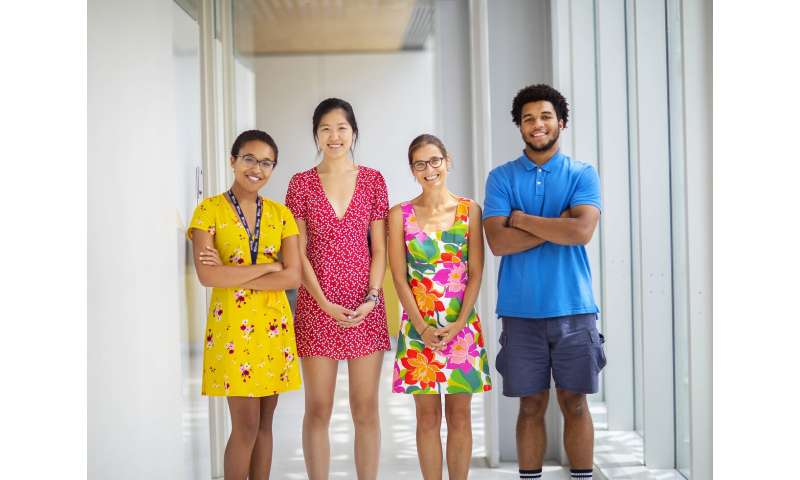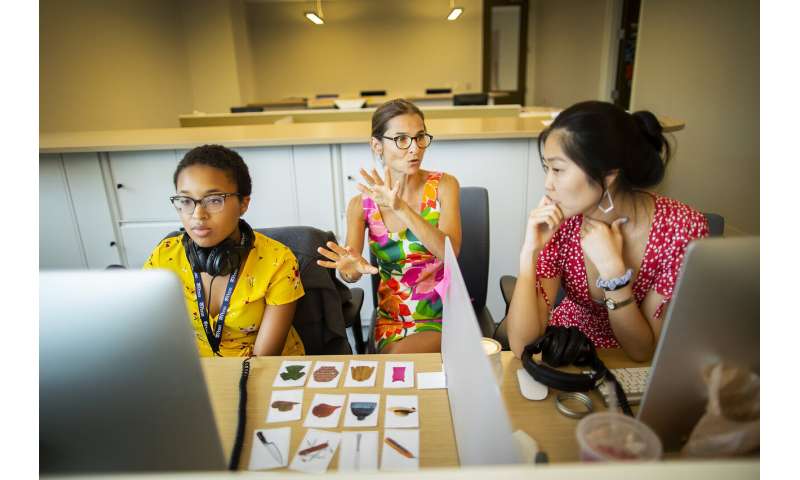
Picture a set of cards with images of ordinary objects such as a kitchen knife or a red baseball hat arranged in a four-by-four grid. A friend sits across from you behind an opaque screen looking at another set of the exact same cards but placed in a different order. Your task: to help her rearrange them so they match the lineup you see.
If you were participating in this conversation experiment, Penn cognitive psychologist Delphine Dahan and a trio of interns would record the interactions, then analyze your word choices. Do you describe the knife as “a silver knife” or “the kitchen knife”? For the cap, do you say, “A red hat with white lining” or maybe “the Cincinnati Reds baseball hat”? The possibilities for each image are vast, but to the research team the specific words you select don’t matter as much as those your friend subsequently uses when it’s later their turn to explain each card.
“The first time, it’s not important how you discuss it because that’s creating the backdrop, the common ground,” says Dahan, an associate professor in the Department of Psychology. “When people discuss it the second or third time, we want to see whether they make use of the first experience.”
It’s a question sophomore Lilian Zhang, junior Kassidy Houston, and Benjamin Stallworth, a student at the University of Chicago, helped to answer for 10 weeks this summer as interns in the Dahan lab, awarded through the Penn Undergraduate Research and Mentoring program, part of the Center for Undergraduate Research and Fellowships. They recruited participants, ran the experiments, and coded the video and audio to look for patterns in language use. Ultimately, the work’s aim is to better understand what subconsciously happens during communications and which mechanisms in the mind are at work.
“Sometimes when I interact with people, it’s particularly hard to make sense of each other. In other words, they don’t understand what I mean, and I don’t understand what they mean. I’ve asked myself, “Why is that?”” Dahan explains. “Part of it is that there are so many decisions that we make without being aware of them.”
Previously Dahan ran a similar matching study using configurations of rectangular, triangular, and square geometric shapes called tangrams. Because tangrams aren’t part of everyday vernacular, there isn’t one conventional way to describe them, forcing significant back and forth between two parties to comprehend each other. With tangrams, however, the conversations required a high vocabulary level, making them accessible to only a certain population. Dahan set out to build a study that could test the conversational process of any native English speaker 18 or older.

That’s the origin of the object cards, which include several types of shoes, shirts, and hats, plus three types of knives. “We picked them so you would need zero expertise,” says Dahan.
With the protocol in place, the students took the lead, recruiting participants with an ad on Craigslist, running each matching game, administering personality questionnaires, paying participants, all of it supported by Dahan’s behind-the-scenes guidance. The biggest portion of the work was listening to, coding, and analyzing each conversation.
“It’s interesting to hear how people come up with descriptions for certain cards,” says Zhang, originally from Beijing. “Someone who came in referred to the cowboy hat as “Old Town Road,””—the 2019 breakout summer rap-country hit from Lil Nas X—”and the other person immediately began referring to it that way as well. That really fit with the idea that once a common ground is established, everyone continues to refer to that object in that manner.”
Houston, from Huntersville, North Carolina, noticed that participant demographics changed how people described certain objects. “Someone who is older wouldn’t have referred to that card as ‘Old Town Road,'” she explains. “People used pop culture to refer to things in ways that I don’t think those of different generations would. Also, there are no brands or labels of any kind on the cards, so it’s really interesting what people project onto them.”
Though the internship has formally ended for the three students, full analysis of the hours of conversation is ongoing. Both Zhang and Houston say they had a great experience. Zhang had hoped for and got lab work beyond the wet lab, a chance to interact with people rather than fruit flies. For Houston, the internship provided an opportunity to dip her toes into academic research before deciding to pursue it as a career. They both valued the closeness they developed with Dahan. “I don’t know any other professors in this context,” Houston says.
Source: Read Full Article
